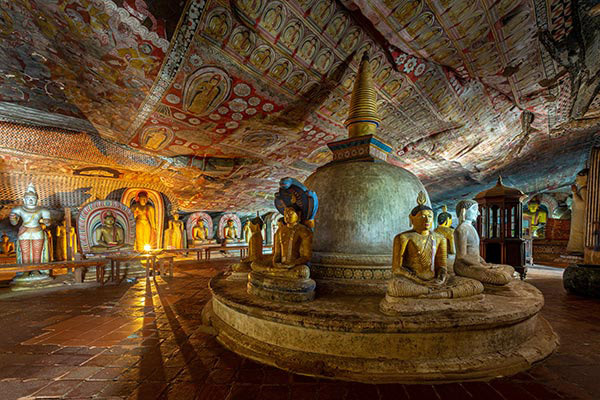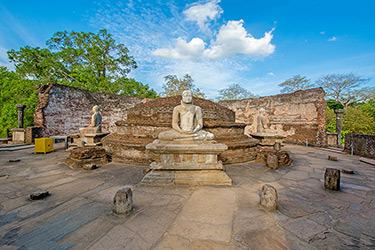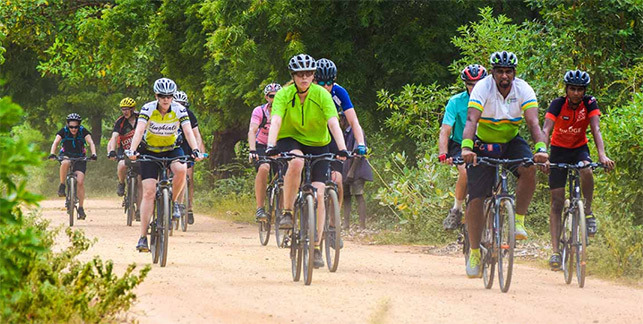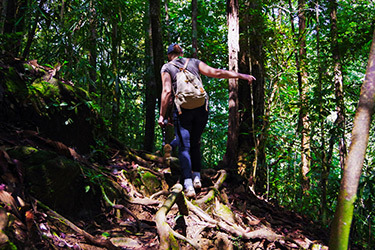We hope you are looking forward to the reopening of the borders and resumption of Tourism once again.
The second wave of COVID in India has almost subsided and the number of cases and positivity rate has gone down significantly. With the achieving of some land mark figures in India in the past few days like administering more than 08 million jabs in a single day, almost 5.5 million jabs getting administered on a daily basis and opening of borders (Bhutan expected to be open for travelers from Sep / Oct 21, Srilanka is already open under bio bubble concept and Nepal again re opening the International flights on 24th June), we are looking forward to resumption of normalcy and Tourism in the Indian Subcontinent soon.
We hope this journey through the rich culture of Indian Subcontinent in our last editions was delightful. So, here we are with one more edition that will take you through “Srilanka - Home to eight magnificent UNESCO World Heritage Sites” that can be added in the itinerary of your clients on a Sri Lanka trip.
Poetically known as the “Tear Drop of India” or the “Pearl of Indian Ocean,” Sri Lanka is one of the Indian Ocean’s crowning jewels. Formerly known as Ceylon, this land is a center of religion and culture, encompassing Buddhism, Hinduism, Christianity, and Islam. Its geographic location and deep harbors made it an important location of the Silk Route. With 103 rivers, several estuaries, lagoons and dense mangrove system spanning over 70 sq km, Sri Lanka is one of the 25 biodiversity hotspots globally, with the highest biodiversity density in Asia. It is also home to eight magnificent UNESCO World Heritage Sites.
Here we will share the significance and importance of these UNESCO World Heritage Sites, including cultural and natural landmarks.
1. Dambulla Cave Temple
 One of Sri Lanka’s greatest hidden wonders, the cave temple, has stood since the 1st century BC. Inhabited by Buddhist monks since the 3rd century BC, it still operates as a practicing place of worship for thousands, making it a must-see pilgrimage on a journey. In the 1st century BC, King Valagamba used the caves for refuge during his 14-year exile from the Anuradhapura Kingdom. Buddhist monks who meditated in Dambulla’s caves provided protection to the king from his many enemies – a gesture that didn’t go unnoticed. When King Valagamba returned to the throne at Anuradhapura, he had a majestic rock temple built at Dambulla as a token of his gratitude to the Dambulla monks.
One of Sri Lanka’s greatest hidden wonders, the cave temple, has stood since the 1st century BC. Inhabited by Buddhist monks since the 3rd century BC, it still operates as a practicing place of worship for thousands, making it a must-see pilgrimage on a journey. In the 1st century BC, King Valagamba used the caves for refuge during his 14-year exile from the Anuradhapura Kingdom. Buddhist monks who meditated in Dambulla’s caves provided protection to the king from his many enemies – a gesture that didn’t go unnoticed. When King Valagamba returned to the throne at Anuradhapura, he had a majestic rock temple built at Dambulla as a token of his gratitude to the Dambulla monks.
The colors of the temple statues have been preserved by being in the dark interiors of the cave and away from the harsh effects of natural light. As a result, they haven’t aged in the same way as other monuments from the same era, which is remarkable to see up close and first-hand.
2. Sigiriya Rock Fortress
 Sigiriya, a 5th-century rock-fortress citadel, is located in the Central Province of Sri Lanka. Abounding in legend, the fortress’s origin is attributed variously to several mythological characters, the most popular being King Kubera, half-brother of Ravana, the antagonist of Indian epic, Ramayana. Historically, it was King Kashyapa’s capital from 477 to 495 CE. Rising sharply above the rest of its surroundings, the flat plane on the top of the hill contains the vestiges of a grand city. With its geometrically designed gardens, pools, and paintings, the citadel reflects the Monarch’s tastes.
Sigiriya, a 5th-century rock-fortress citadel, is located in the Central Province of Sri Lanka. Abounding in legend, the fortress’s origin is attributed variously to several mythological characters, the most popular being King Kubera, half-brother of Ravana, the antagonist of Indian epic, Ramayana. Historically, it was King Kashyapa’s capital from 477 to 495 CE. Rising sharply above the rest of its surroundings, the flat plane on the top of the hill contains the vestiges of a grand city. With its geometrically designed gardens, pools, and paintings, the citadel reflects the Monarch’s tastes.
The Lion Staircase leading up to the summit has a massive lion paw carved out of the rock. Frescoes of slender, bejeweled women that decorate several of the fort’s wall surfaces glow in vibrant colors. An extraordinary feature of this place is the mirror wall, which, in its time, was a highly-polished surface that would cast a mirror-like reflection of the passer-by.
Today, the wall is partially covered in verses known as “Sigiri Graffiti,” which are poems dating back to the 8th century. A UNSECO site, Sigiriya, is currently being excavated and restored under UNESCO’s Cultural Triangle Project and could be the future eighth Wonder of the World.
3. Ancient city of Polonnaruwa
 Polonnaruwa (known as Pulasthipura in the ancient times) was the Capital of Sri Lanka between the 11th - 13th centuries. The city contains some of the most beautiful and magnificent statues. Polonnaruwa’s main sites are the conserved ruins of massive Buddhist temples, splendid royal palaces, enormous unbroken statues carved from solid boulders, and ancient irrigation reservoirs. Lankatilake, Tivanka, and Thuparama are the most impressive and largest shrine ruins. Tivanka is considered to be the best example of frescoes of the Polonnaruwa period. The other places of interest are Buddha Statues at Gal Viharaya, Vata-da-Geya, Moonstone, Pothgul Vehera, and others. The best way to enjoy the unhindered beauty of Polonnaruwa is on bikes.
Polonnaruwa (known as Pulasthipura in the ancient times) was the Capital of Sri Lanka between the 11th - 13th centuries. The city contains some of the most beautiful and magnificent statues. Polonnaruwa’s main sites are the conserved ruins of massive Buddhist temples, splendid royal palaces, enormous unbroken statues carved from solid boulders, and ancient irrigation reservoirs. Lankatilake, Tivanka, and Thuparama are the most impressive and largest shrine ruins. Tivanka is considered to be the best example of frescoes of the Polonnaruwa period. The other places of interest are Buddha Statues at Gal Viharaya, Vata-da-Geya, Moonstone, Pothgul Vehera, and others. The best way to enjoy the unhindered beauty of Polonnaruwa is on bikes.
4. Anuradhapura
 The first historical capital of Sri Lanka, the city of Anuradhapura, was founded around the 5th century BCE. During that time, it was one of the most stable centers of political power in South Asia.
The first historical capital of Sri Lanka, the city of Anuradhapura, was founded around the 5th century BCE. During that time, it was one of the most stable centers of political power in South Asia.
A World Heritage Site, the city was the nucleus of Theravada Buddhism and is considered sacred by the Buddhists world over.
With its gigantic Buddhist shrines, splendid palaces, pavilions, parks, and bathing ponds, the city gives us a glimpse of the stately, well laid-out metropolis this city used to be.
The documented account refers to Anuradhapura as the first capital of Sri Lanka. The city still holds relics of architectural ruins of the ancient kingdoms and Buddhist temples that cannot be seen in most parts of the world. Anuradhapura is truly an ancient city with a deep heritage, culture, politics, and religious history. Some of the most famous monuments here are Brazen Palace’s ruins and the impressive Ruwanwelisaya built by majestic King Dutugamunu. Mahamevuna Uyana houses the Sacred Bo-tree of Sri Maha Bodhi, the oldest authenticated sacred tree, planted from a sapling from the Mahabodhi tree in Bodhgaya in India, under which the Lord Buddha attained enlightenment. Another magnificent sight is Jetavanaramaya, the largest Dagaba in the world. The city is spread with ruins of ancient Dagabas and other sites of religious significance.
5. Kandy
 The last capital of the Kingdom, Kandy, is a repository of traditional culture and the Island’s most frequented tourist resort. Set amidst tea and spice gardens, lakes, mountains, and a river, Kandy’s varied charm offers memorable sights and scenes. Accessing Kandy from Colombo through the Kadugannawa and Balane Passes takes the traveler on a scenic and dramatic journey, aptly suited to a medieval mountain capital.
The last capital of the Kingdom, Kandy, is a repository of traditional culture and the Island’s most frequented tourist resort. Set amidst tea and spice gardens, lakes, mountains, and a river, Kandy’s varied charm offers memorable sights and scenes. Accessing Kandy from Colombo through the Kadugannawa and Balane Passes takes the traveler on a scenic and dramatic journey, aptly suited to a medieval mountain capital.
Since the times when the Buddha’s Tooth was taken to Sri Lanka hidden in an Orissan princess’ hair, away from other kingdoms’ sinful hands, the relic has grown in its reputation and sacredness in Sri Lanka and throughout the world. Sri Dalada Maligawa, famously known as the “Temple of the Sacred Tooth Relic,” houses the most sacred Tooth Relic of Lord Buddha.
Every evening, there is a beautiful ceremony inside the temple, which is worth a visit. Historical procession called “Esala Perahera” is held annually during July to pay homage to the Sacred Tooth Relic of Lord Buddha.
While in Kandy, one should not miss the fun-filled Cycling from Hantana to Peredinya. The Hanthana massif is in the south-west of Kandy. The lovely experience of riding a bike on the back roads of Kandy, winding through tea estates and smaller towns is mostly a downhill back road cycling trip. The starting point is in front of the Ceylon Tea Museum at the top of the Hanthana Hill, riding down through winding back roads ending at Peradeniya University. The ride is undulating down with a few climbs and rewarding views of the surrounding valleys, tea estates, and small-town village life.
As a community development program, we generally encourage volunteering at a ‘Speak-in-English’ class here. A group of villagers (aged between 05 and 50 years) gather around a mud house for a two hour English speaking class every Saturday evening. It is their ambition to speak fluent English that brings them here every weekend. It is nothing like attending a school session, but it is a fun way of learning, which is filled with many activities focusing on verbal thoroughness. The activities may include games, storytelling, role-playing and speeches, singing, debates, and much more. To encourage participants, every week, the most active participant is rewarded as well. During your visit here, teach, talk, sing, play, have fun and, most importantly, be a part of the community, with a deep curiosity to learn.
6. Central Highlands of Sri Lanka
 Central Highlands is a protected land full of natural beauty in the south-central part of Sri Lanka. The Horton Plains, The Knuckles Conservation Forest, and The Peak Wilderness Protected Area are the main three areas under Central Highlands. Interestingly, here the land rises to 8,000 FT above the sea level. Central Highlands is home to astonishing flora and fauna, including numerous endangered species such as the Horton Plains Slender Loris, the western purple-faced Langur, and the Sri Lankan Leopard, which is one of the main reasons UNESCO chose it as a World Heritage Site.
Central Highlands is a protected land full of natural beauty in the south-central part of Sri Lanka. The Horton Plains, The Knuckles Conservation Forest, and The Peak Wilderness Protected Area are the main three areas under Central Highlands. Interestingly, here the land rises to 8,000 FT above the sea level. Central Highlands is home to astonishing flora and fauna, including numerous endangered species such as the Horton Plains Slender Loris, the western purple-faced Langur, and the Sri Lankan Leopard, which is one of the main reasons UNESCO chose it as a World Heritage Site.
The site conserves the largest remaining submontane and montane rainforest in Sri Lanka. It also protects the habitat of a collection of species displaying extraordinary endemism levels, many of which are site endemic.
Major area of the Central Highlands of Sri Lanka:
• The Knuckles Mountain Range, a paradise for trekkers, lies in central Sri Lanka. The mountain range gets its name from a series of reclining folds and peaks that resemble knuckles of a clenched fist when seen from a few locations.
While the name was given by early British surveyors, the locals have traditionally referred to it as Dumbara Kanduvetiya, which means a Mist-laden Mountain Range.
• Horton Plains National Park is a great highland plateau situated at an elevation of 2100 -2300 meters above sea level and is capped by montane grassland and cloud forest. Many species found here are endemic to the region.
One of the most-visited parts of Horton Plains and heaven for trekkers and bird watchers is the “The World’s End.” It is a 700 meters vertical drop that gives a superb view of the valley, and the beautiful watercourses of Baker’s waterfall make it even more interesting for the visitors.
• Peak Wilderness sanctuary is a natural reserve in Sri Lanka, the third largest of its 50 sanctuaries. It is spread over a land of 224 sq km around the Sri Pada Mountain. The stunning Adam’s Peak stands tall at 7360 feet and is identified by Buddhists as the Buddha’s footprint, by Hindus as Shiva, and by Muslims as Adam. It is considered to be one of the holiest places for many religions in Sri Lanka. Be sure to include a night trek to Adam’s peak to behold the most spectacular sunrise your clients would ever see in life.
7. Galle
 Situated approx. 116 kilometers from Colombo, Galle’s sea-side town has been around since the 16th century and has stood the test of time through the colonial periods of the Portuguese, the Dutch, and the British.
Situated approx. 116 kilometers from Colombo, Galle’s sea-side town has been around since the 16th century and has stood the test of time through the colonial periods of the Portuguese, the Dutch, and the British.
A perfect example of a walled or fortified city built by the Portuguese in Asia, Galle reached its peak in the 18th century, during the Dutch colonial period. Today, Galle has been declared as an archaeological reserve and a World Heritage Site.
The best way to get a quick outlook of the UNESCO world heritage site is by taking a walking tour. From architecture to culture to people, this walk touches all aspects that best defines and describes the fort.
8. Sinharaja Rain Forest
 A unique lowland rain forest spread across 11,187 hectares, the Sinharaja Forest Reserve is a biodiversity hotspot and one of the least disturbed forests in Sri Lanka. Declared a National Heritage Area in 1988 and a World Heritage Site later on, the forest is bounded by rivers on three sides—Kalu Ganga in the north, Gin Ganga in the south, and Kudawa Ganga in the west. A series of unbroken ridges, aligned east to west, define the topography of this place. Several butterflies, fish, amphibians, reptiles, birds, and mammals are unique to this reserve.
A unique lowland rain forest spread across 11,187 hectares, the Sinharaja Forest Reserve is a biodiversity hotspot and one of the least disturbed forests in Sri Lanka. Declared a National Heritage Area in 1988 and a World Heritage Site later on, the forest is bounded by rivers on three sides—Kalu Ganga in the north, Gin Ganga in the south, and Kudawa Ganga in the west. A series of unbroken ridges, aligned east to west, define the topography of this place. Several butterflies, fish, amphibians, reptiles, birds, and mammals are unique to this reserve.
While at Sinharaja Rain Forest, do not forget to take the nature trail with an experienced Guide. This nature trail is a full day visit to Sinharaja Rainforest for lowland endemics and mixed-species bird flocks.
Sri Lanka is a beautiful country blessed with lovely landscapes, lush green tea gardens, unique culture, historic sites, and much more. We, at Indo Asia Tours, are all about the handcrafted tours, memories, and moments you take out of your trip, and believe us, this escapade will be a life-changing one!

 One of Sri Lanka’s greatest hidden wonders, the cave temple, has stood since the 1st century BC. Inhabited by Buddhist monks since the 3rd century BC, it still operates as a practicing place of worship for thousands, making it a must-see pilgrimage on a journey. In the 1st century BC, King Valagamba used the caves for refuge during his 14-year exile from the Anuradhapura Kingdom. Buddhist monks who meditated in Dambulla’s caves provided protection to the king from his many enemies – a gesture that didn’t go unnoticed. When King Valagamba returned to the throne at Anuradhapura, he had a majestic rock temple built at Dambulla as a token of his gratitude to the Dambulla monks.
One of Sri Lanka’s greatest hidden wonders, the cave temple, has stood since the 1st century BC. Inhabited by Buddhist monks since the 3rd century BC, it still operates as a practicing place of worship for thousands, making it a must-see pilgrimage on a journey. In the 1st century BC, King Valagamba used the caves for refuge during his 14-year exile from the Anuradhapura Kingdom. Buddhist monks who meditated in Dambulla’s caves provided protection to the king from his many enemies – a gesture that didn’t go unnoticed. When King Valagamba returned to the throne at Anuradhapura, he had a majestic rock temple built at Dambulla as a token of his gratitude to the Dambulla monks.
 Sigiriya, a 5th-century rock-fortress citadel, is located in the Central Province of Sri Lanka. Abounding in legend, the fortress’s origin is attributed variously to several mythological characters, the most popular being King Kubera, half-brother of Ravana, the antagonist of Indian epic, Ramayana. Historically, it was King Kashyapa’s capital from 477 to 495 CE. Rising sharply above the rest of its surroundings, the flat plane on the top of the hill contains the vestiges of a grand city. With its geometrically designed gardens, pools, and paintings, the citadel reflects the Monarch’s tastes.
Sigiriya, a 5th-century rock-fortress citadel, is located in the Central Province of Sri Lanka. Abounding in legend, the fortress’s origin is attributed variously to several mythological characters, the most popular being King Kubera, half-brother of Ravana, the antagonist of Indian epic, Ramayana. Historically, it was King Kashyapa’s capital from 477 to 495 CE. Rising sharply above the rest of its surroundings, the flat plane on the top of the hill contains the vestiges of a grand city. With its geometrically designed gardens, pools, and paintings, the citadel reflects the Monarch’s tastes.
 Polonnaruwa (known as Pulasthipura in the ancient times) was the Capital of Sri Lanka between the 11th - 13th centuries. The city contains some of the most beautiful and magnificent statues. Polonnaruwa’s main sites are the conserved ruins of massive Buddhist temples, splendid royal palaces, enormous unbroken statues carved from solid boulders, and ancient irrigation reservoirs. Lankatilake, Tivanka, and Thuparama are the most impressive and largest shrine ruins. Tivanka is considered to be the best example of frescoes of the Polonnaruwa period. The other places of interest are Buddha Statues at Gal Viharaya, Vata-da-Geya, Moonstone, Pothgul Vehera, and others. The best way to enjoy the unhindered beauty of Polonnaruwa is on bikes.
Polonnaruwa (known as Pulasthipura in the ancient times) was the Capital of Sri Lanka between the 11th - 13th centuries. The city contains some of the most beautiful and magnificent statues. Polonnaruwa’s main sites are the conserved ruins of massive Buddhist temples, splendid royal palaces, enormous unbroken statues carved from solid boulders, and ancient irrigation reservoirs. Lankatilake, Tivanka, and Thuparama are the most impressive and largest shrine ruins. Tivanka is considered to be the best example of frescoes of the Polonnaruwa period. The other places of interest are Buddha Statues at Gal Viharaya, Vata-da-Geya, Moonstone, Pothgul Vehera, and others. The best way to enjoy the unhindered beauty of Polonnaruwa is on bikes.
 The first historical capital of Sri Lanka, the city of Anuradhapura, was founded around the 5th century BCE. During that time, it was one of the most stable centers of political power in South Asia.
The first historical capital of Sri Lanka, the city of Anuradhapura, was founded around the 5th century BCE. During that time, it was one of the most stable centers of political power in South Asia.
 The last capital of the Kingdom, Kandy, is a repository of traditional culture and the Island’s most frequented tourist resort. Set amidst tea and spice gardens, lakes, mountains, and a river, Kandy’s varied charm offers memorable sights and scenes. Accessing Kandy from Colombo through the Kadugannawa and Balane Passes takes the traveler on a scenic and dramatic journey, aptly suited to a medieval mountain capital.
The last capital of the Kingdom, Kandy, is a repository of traditional culture and the Island’s most frequented tourist resort. Set amidst tea and spice gardens, lakes, mountains, and a river, Kandy’s varied charm offers memorable sights and scenes. Accessing Kandy from Colombo through the Kadugannawa and Balane Passes takes the traveler on a scenic and dramatic journey, aptly suited to a medieval mountain capital.
 Central Highlands is a protected land full of natural beauty in the south-central part of Sri Lanka. The Horton Plains, The Knuckles Conservation Forest, and The Peak Wilderness Protected Area are the main three areas under Central Highlands. Interestingly, here the land rises to 8,000 FT above the sea level. Central Highlands is home to astonishing flora and fauna, including numerous endangered species such as the Horton Plains Slender Loris, the western purple-faced Langur, and the Sri Lankan Leopard, which is one of the main reasons UNESCO chose it as a World Heritage Site.
Central Highlands is a protected land full of natural beauty in the south-central part of Sri Lanka. The Horton Plains, The Knuckles Conservation Forest, and The Peak Wilderness Protected Area are the main three areas under Central Highlands. Interestingly, here the land rises to 8,000 FT above the sea level. Central Highlands is home to astonishing flora and fauna, including numerous endangered species such as the Horton Plains Slender Loris, the western purple-faced Langur, and the Sri Lankan Leopard, which is one of the main reasons UNESCO chose it as a World Heritage Site.
 Situated approx. 116 kilometers from Colombo, Galle’s sea-side town has been around since the 16th century and has stood the test of time through the colonial periods of the Portuguese, the Dutch, and the British.
Situated approx. 116 kilometers from Colombo, Galle’s sea-side town has been around since the 16th century and has stood the test of time through the colonial periods of the Portuguese, the Dutch, and the British.  A unique lowland rain forest spread across 11,187 hectares, the Sinharaja Forest Reserve is a biodiversity hotspot and one of the least disturbed forests in Sri Lanka. Declared a National Heritage Area in 1988 and a World Heritage Site later on, the forest is bounded by rivers on three sides—Kalu Ganga in the north, Gin Ganga in the south, and Kudawa Ganga in the west. A series of unbroken ridges, aligned east to west, define the topography of this place. Several butterflies, fish, amphibians, reptiles, birds, and mammals are unique to this reserve.
A unique lowland rain forest spread across 11,187 hectares, the Sinharaja Forest Reserve is a biodiversity hotspot and one of the least disturbed forests in Sri Lanka. Declared a National Heritage Area in 1988 and a World Heritage Site later on, the forest is bounded by rivers on three sides—Kalu Ganga in the north, Gin Ganga in the south, and Kudawa Ganga in the west. A series of unbroken ridges, aligned east to west, define the topography of this place. Several butterflies, fish, amphibians, reptiles, birds, and mammals are unique to this reserve.
 We can conduct a virtual destination awareness training program for your team or yourself or a virtual tour for your clients. Let us know the destination of your interest along with your convenient date / time and we will be happy to set up a program for you.
We can conduct a virtual destination awareness training program for your team or yourself or a virtual tour for your clients. Let us know the destination of your interest along with your convenient date / time and we will be happy to set up a program for you.




